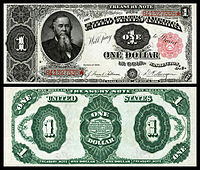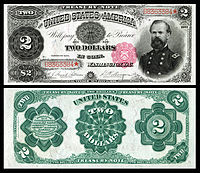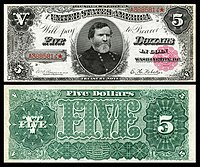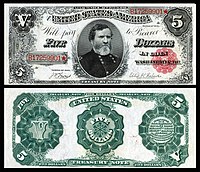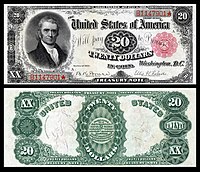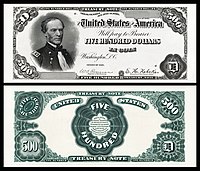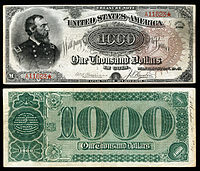
Federal Reserve Notes are the currently issued banknotes of the United States dollar. The United States Bureau of Engraving and Printing produces the notes under the authority of the Federal Reserve Act of 1913 and issues them to the Federal Reserve Banks at the discretion of the Board of Governors of the Federal Reserve System. The Reserve Banks then circulate the notes to their member banks, at which point they become liabilities of the Reserve Banks and obligations of the United States.
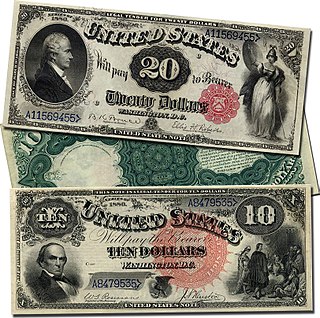
A United States Note, also known as a Legal Tender Note, is a type of paper money that was issued from 1862 to 1971 in the United States. Having been current for 109 years, they were issued for longer than any other form of U.S. paper money other than the currently issued Federal Reserve Note. They were known popularly as "greenbacks", a name inherited from the earlier greenbacks, the Demand Notes, that they replaced in 1862. Often termed Legal Tender Notes, they were named United States Notes by the First Legal Tender Act, which authorized them as a form of fiat currency. During the early 1860s the so-called second obligation on the reverse of the notes stated:
This Note is a Legal Tender for all debts public and private except Duties on Imports and Interest on the Public Debt; and is receivable in payment of all loans made to the United States.

The United States ten-dollar bill (US$10) is a denomination of U.S. currency. The obverse of the bill features the portrait of Alexander Hamilton, who served as the first U.S. Secretary of the Treasury, two renditions of the torch of the Statue of Liberty, and the words "We the People" from the original engrossed preamble of the United States Constitution. The reverse features the U.S. Treasury Building. All $10 bills issued today are Federal Reserve Notes.

The United States one-hundred-dollar bill (US$100) is a denomination of United States currency. The first United States Note with this value was issued in 1862 and the Federal Reserve Note version was first produced in 1914. Inventor and U.S. Founding Father Benjamin Franklin has been featured on the obverse of the bill since 1914, which now also contains stylized images of the Declaration of Independence, a quill pen, the Syng inkwell, and the Liberty Bell. The reverse depicts Independence Hall in Philadelphia, which it has featured since 1928.
Large denominations of United States currency greater than $100 were circulated by the United States Treasury until 1969. Since then, U.S. dollar banknotes have been issued in seven denominations: $1, $2, $5, $10, $20, $50, and $100.

Silver certificates are a type of representative money issued between 1878 and 1964 in the United States as part of its circulation of paper currency. They were produced in response to silver agitation by citizens who were angered by the Fourth Coinage Act, which had effectively placed the United States on a gold standard. The certificates were initially redeemable for their face value of silver dollar coins and later in raw silver bullion. Since 1968 they have been redeemable only in Federal Reserve Notes and are thus obsolete, but still valid legal tender at their face value and thus are still an accepted form of currency.

Gold certificates were issued by the United States Treasury as a form of representative money from 1865 to 1933. While the United States observed a gold standard, the certificates offered a more convenient way to pay in gold than the use of coins. General public ownership of gold certificates was outlawed in 1933 and since then they have been available only to the Federal Reserve Banks, with book-entry certificates replacing the paper form.
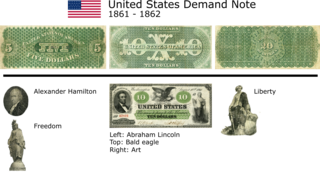
A Demand Note is a type of United States paper money that was issued from August 1861 to April 1862 during the American Civil War in denominations of 5, 10, and 20 US$. Demand Notes were the first issue of paper money by the United States that achieved wide circulation. The U.S. government placed Demand Notes into circulation by using them to pay expenses incurred during the Civil War including the salaries of its workers and military personnel.

The Confederate States dollar was first issued just before the outbreak of the American Civil War by the newly formed Confederacy. It was not backed by hard assets, but simply by a promise to pay the bearer after the war, on the prospect of Southern victory and independence. As the Civil War progressed and victory for the South seemed less and less likely, its value declined. After the Confederacy's defeat, its money had no value, and individuals and banks lost large sums.

Fractional currency, also referred to as shinplasters, was introduced by the United States federal government following the outbreak of the Civil War. These low-denomination banknotes of the United States dollar were in use between August 21, 1862, and February 15, 1876, and issued in denominations of 3, 5, 10, 15, 25, and 50 cents across five issuing periods. The complete type set below is part of the National Numismatic Collection, housed at the National Museum of American History, part of the Smithsonian Institution.

Greenbacks were emergency paper currency issued by the United States during the American Civil War that were printed in green on the back. They were in two forms: Demand Notes, issued in 1861–1862, and United States Notes, issued in 1862–1865. A form of fiat money, the notes were legal tender for most purposes and carried varying promises of eventual payment in coin but were not backed by existing gold or silver reserves.
Bills of credit are documents similar to banknotes issued by a government that represent a government's indebtedness to the holder. They are typically designed to circulate as currency or currency substitutes. Bills of credit are mentioned in Article One, Section 10, Clause One of the United States Constitution, where their issuance by state governments is prohibited.

Interest bearing notes refers to a grouping of Civil War era paper money-related emissions of the US Treasury. The grouping includes the one- and two-year notes authorized by the Act of March 3, 1863, which bore interest at five percent per annum, were a legal tender at face value, and were issued in denominations of $10, $20, $50, $100, $500 and $1000. The grouping also frequently includes the early civil war treasury notes which matured in either sixty days or two years and bore interest at six percent and the seven-thirties which matured in three years and bore interest at 7.3 percent—though both of these latter issues lacked legal tender status. Reference texts used by currency collectors will also sometimes include compound interest treasury notes and Refunding Certificates in this grouping as well.
From 1775 to 1779, the Continental Congress issued Continental currency banknotes. Then there was a period when the United States just used gold and silver, rather than paper currency. In 1812, the US began issuing Treasury Notes, although the motivation behind their issuance was funding federal expenditures rather than the provision of a circulating medium. In 1861, the US began issuing Demand Notes, which were the first paper money issued by the United States whose main purpose was to circulate. And since 1914, the US has issued Federal Reserve Notes.
In early 18th century Colonial America, engravers began experimenting with copper plates as an alternative medium to wood. Applied to the production of paper currency, copper-plate engraving allowed for greater detail and production during printing. It was the transition to steel engraving that enabled banknote design and printing to rapidly advance in the United States during the 19th century.

US Treasury Department Specimen books, also known as BEP presentation albums, were published by the Bureau of Engraving and Printing (BEP) from the mid-1860s through the 1910s. Prepared upon request of the United States Secretary of the Treasury, albums were generally presented to Cabinet members, select Members of Congress, diplomats and visiting dignitaries. Some extant albums still in their original binding bear the name of the recipient impressed in gold lettering on the cover. While no two presentation albums have exactly the same contents, each book usually contained portraits, vignettes, and/or images of buildings. Specimen books which contain whole proof images of currency are extremely rare.

Cuban silver certificates were banknotes issued by the Cuban government between 1934 and 1949. Prior and subsequent issues of Cuban banknotes were engraved and printed by nongovernmental private bank note companies in the United States, but the series from 1934 to 1949 were designed, engraved, and printed by the US government at the Bureau of Engraving and Printing (BEP).
A silver certificate is a certificate of ownership that silver owners hold instead of storing the actual silver. Several countries have issued silver certificates, including Cuba, the Netherlands, and the United States. Silver certificates have also been privately issued by various mints and bullion companies. One example was the Liberty Dollar issued by NORFED from 1998 to 2009.

The United States two-dollar bill (US$2) is a current denomination of United States currency. A portrait of Thomas Jefferson, the third president of the United States (1801–1809), is featured on the obverse of the note. The reverse features an engraving of John Trumbull's painting Declaration of Independence.

The United States 5000 dollar Bill(US$5000) is an obsolete denomination of United States currency. It is still legal tender. The United States Department of the Treasury discontinued the note $5000 bill in 1969 and it is now valued by currency collectors.


